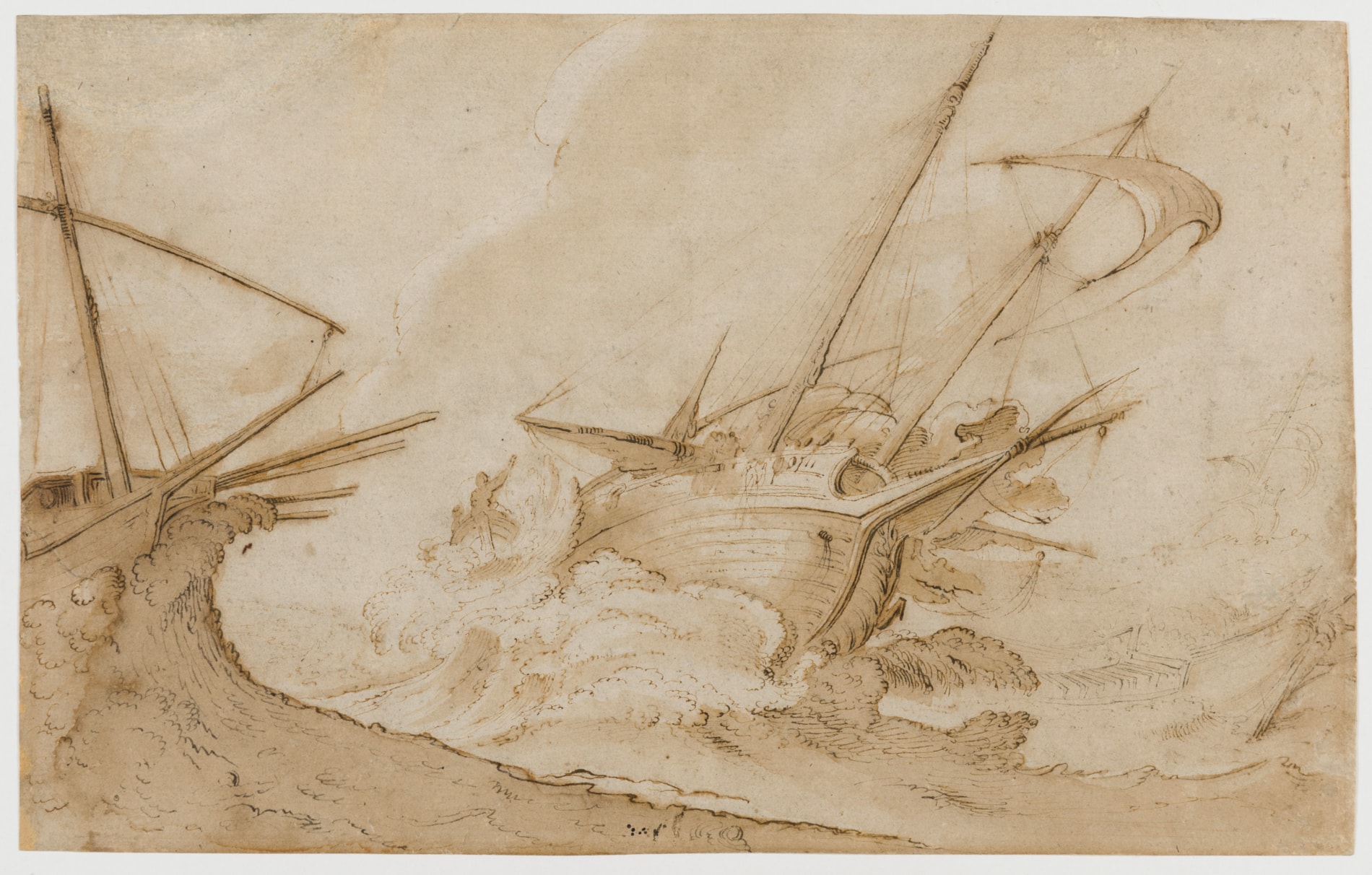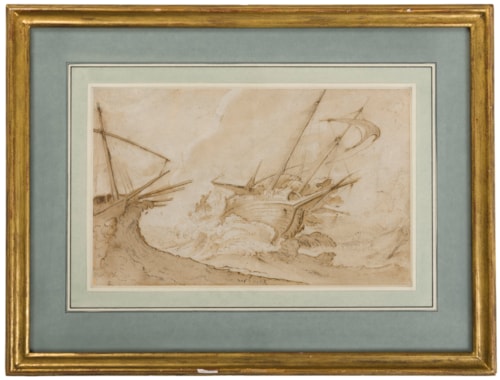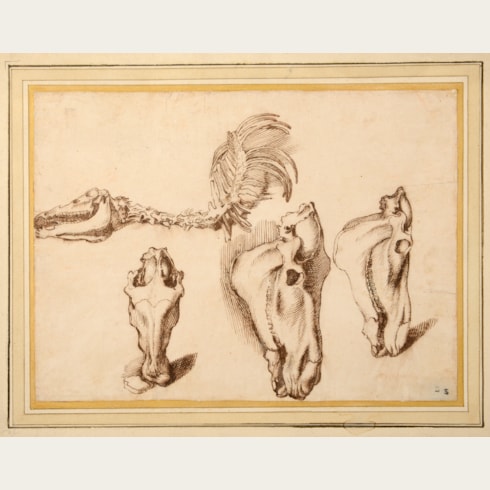Filippo NAPOLETANO
(Naples or Rome 1589 - Rome 1629)
Ships on a Stormy Sea
Pen and two shades of brown ink and brown wash.
Made up at the top left corner, and the sheet backed.
165 x 257 mm. (6 1/2 x 10 1/8 in.)
Made up at the top left corner, and the sheet backed.
165 x 257 mm. (6 1/2 x 10 1/8 in.)
Both thematically and stylistically, the present sheet may be compared with a number of drawings by Filippo Napoletano, such as a large and impressive Naval Battlein the Louvre. Another drawing of ships on a stormy sea, more freely executed in pen and brown wash, is in the Art Institute of Chicago, while a study of a Shipwreck in the Albertina in Vienna may also be compared to the present sheet. Perhaps the closest compositional comparison, however, may be made – as Marco Chiarini has noted - with a drawing of Boats in a Storm in the collection of the Biblioteca Academiei Romî in Bucharest.
The attribution of this drawing to Filippo Napoletano was confirmed by the late Marco Chiarini. A painting of a similar subject and composition appeared on the art market in Rome in the 1990s with a plausible attribution to Agostino Tassi.
The attribution of this drawing to Filippo Napoletano was confirmed by the late Marco Chiarini. A painting of a similar subject and composition appeared on the art market in Rome in the 1990s with a plausible attribution to Agostino Tassi.
Teodoro Filippo di Liagno, called Filippo d’Angeli but better known as Filippo Napoletano, was a pupil of his father, an artist working in Rome, although he seems to have completed his education in Naples. Around 1614 he returned to Rome, where he encountered the landscape paintings of Agostino Tassi, whose work is sometimes confused with his, and was also influenced by the paintings of Caravaggio and his followers, as well as the German painter Adam Elsheimer. By 1617 he was in Florence, where he was employed alongside Jacques Callot at the court of the Grand Duke Cosimo II de’ Medici. (Indeed, Filippo Baldinucci states that Napoletano was one of Cosimo’s favourite artists). He remained in Florence until 1621 before returning to Rome, where he worked on the decoration of a number of villas and palaces, notably a group of landscape frescoes in the Palazzo Bentivoglio, completed in 1623, and a series of seascapes for the Palazzo Barberini. For the remainder of his career Napoletano worked in both Rome and Naples, producing cabinet pictures of battle scenes, landscapes and marine subjects for private collectors. He also painted a large number of religious and mythological subjects in a distinctive technique of oil on different types of variegated and coloured stone, known as pietra paesina. As a draughtsman, Napoletano was much admired by contemporary collectors such as Cardinal Leopoldo de’ Medici, as well as later connoisseurs like Pierre-Jean Mariette in the 18th century. Significant groups of drawings by the artist are today in the Uffizi, the Louvre and the Musée des Beaux-Arts in Lille.
Provenance
Mathias Komor, New York
Anonymous sale, London, Sotheby’s, 2 July 1990, lot 155 (as attributed to Agostino Tassi)
Galerie Paul Prouté, Paris, in 1993
Anonymous sale, Paris, Hôtel Drouot, 20 October 2000, lot 160
P. & D. Colnaghi, London, in 2003
Private collection, Middlesex
Thence by descent.
Anonymous sale, London, Sotheby’s, 2 July 1990, lot 155 (as attributed to Agostino Tassi)
Galerie Paul Prouté, Paris, in 1993
Anonymous sale, Paris, Hôtel Drouot, 20 October 2000, lot 160
P. & D. Colnaghi, London, in 2003
Private collection, Middlesex
Thence by descent.
Literature
Marco Chiarini, ed., I disegni italiani della Biblioteca dell’Accademia di Romania a Bucarest: Catalogo generale, Florence, 2004, p.74, under no.XXXVII (entry by Marco Chiarini); Marco Chiarini, Teodoro Filippo di Liano detto Filippo Napoletano 1589-1629: Vite e opere, Florence, 2007, pp.460-461, no.388; Heiko Damm and Henning Hoesch, ed., galleria portatile: Italienische Handzeichnungen aus der Sammling Hoesch, Vol.II, Petersberg, 2022, p.170, under no.30, fig.3.






